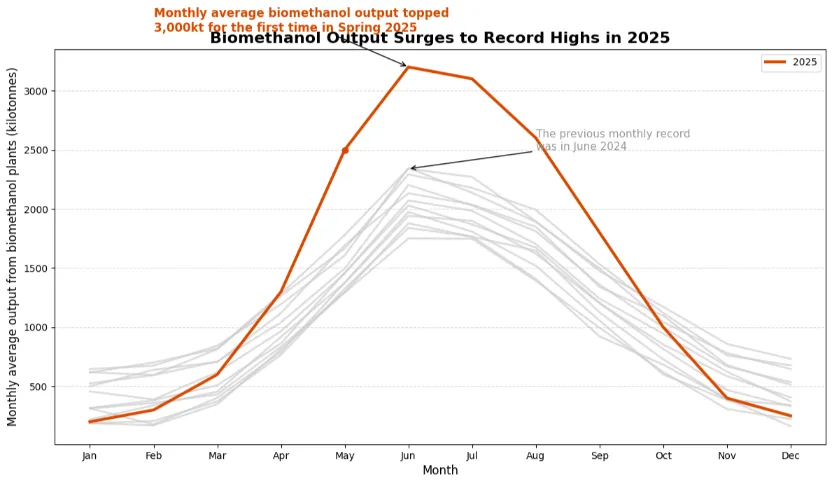
The Dawn of the Biomethanol Revolution
The world is urgently seeking scalable, sustainable, and affordable energy solutions to reduce carbon emissions. While solar and wind power get most of the attention, a significant shift is happening with biomethanol. This renewable fuel is gaining rapid adoption across various industries and could reshape global energy markets by 2030. Biomethanol is proving to be a versatile, low-carbon option that can use existing infrastructure while still achieving major reductions in emissions.
What is Biomethanol?
Biomethanol is a type of methanol produced from renewable sources instead of fossil fuels. It is made from materials like agricultural waste, forestry leftovers, municipal solid waste, or even captured carbon dioxide combined with green hydrogen. Its key features include a low carbon footprint, reducing CO₂ emissions by up to 80% compared to traditional methanol, and its versatility as a fuel, chemical feedstock, or hydrogen carrier. Because it can be transported and stored using existing infrastructure, it offers a practical path to a cleaner energy system.
Why is Biomethanol Important Now?
Global energy systems are under pressure to become cleaner and more secure. Biomethanol meets this need by being scalable, flexible across different sectors like shipping and power generation, and increasingly economically viable. It also aligns with new government policies and carbon regulations, making it an attractive option for a sustainable energy transition.
Five Breakthroughs Driving the Biomethanol Revolution
1. Waste-to-Fuel Technologies: Turning Trash Into Treasure
Advanced technologies now allow us to convert municipal solid waste, agricultural residues, and industrial CO₂ emissions into high-purity biomethanol. Through processes like gasification and anaerobic digestion, this waste is transformed into valuable fuel. This creates a circular economy by reducing landfill use and methane emissions, while also providing cost savings and allowing regions to produce their own renewable fuel. For example, the Netherlands already has operational plants converting waste into biomethanol for local use.
2. Green Hydrogen Integration: Power-to-Methanol
A major game-changer is combining green hydrogen with captured CO₂ to create carbon-neutral “power-to-methanol.” Green hydrogen is produced using renewable electricity to split water. This hydrogen is then combined with CO₂ captured from industrial processes or the air to synthesize methanol. This process helps balance the electrical grid by using excess renewable power, supports deep decarbonization in hard-to-clean sectors, and acts as a form of liquid energy storage. Denmark is a leader in this area with its Power-to-X projects.
3. Shipping and Heavy Transport: Decarbonizing the Hardest Sectors
Shipping and heavy transport are difficult industries to decarbonize. Biomethanol is emerging as a top solution because of its energy density, safety, and compatibility with existing engines. It can be used directly in modified marine engines or in trucks and trains. This helps shipping companies meet strict international emissions standards and offers a cost-effective transition, as existing vessels can be retrofitted instead of replaced. Major companies like Maersk are already investing in methanol-powered ships and the infrastructure to supply them.
4. Chemical Industry Transformation: Greening the Value Chain
The chemical industry is a large consumer of methanol, using it to make plastics, paints, and adhesives. Switching to biomethanol allows these companies to drastically reduce the carbon footprint of their products. It acts as a direct “drop-in” replacement for fossil-based methanol in existing processes. This allows companies to create sustainable products, meet new regulatory demands, and build a more resilient supply chain less dependent on fossil fuels. Major chemical producers like BASF and SABIC are already incorporating biomethanol into their supply chains.
5. Global Policy Alignment and Investment Surge
Transformative support for biomethanol is coming from aligned global policies and a surge in investment. Governments are introducing mandates, subsidies, and carbon pricing that favor renewable fuels. At the same time, investors are pouring billions into new biomethanol projects. This is driving massive market growth, accelerating technological innovation to lower costs, and creating new green jobs. The European Union’s Green Deal is a prime example of policy spurring widespread investment.
The Benefits and Challenges of Biomethanol
Benefits:
- Decarbonization at Scale: It enables significant emissions reductions across multiple sectors.
- Circular Economy: It turns waste streams into valuable resources.
- Energy Security: Local production reduces reliance on imported fossil fuels.
- Economic Opportunity: It creates new markets, jobs, and revenue streams.
Challenges to Overcome:
- Sustainable Feedstock: Ensuring a large-scale supply of biomass and waste that doesn’t compete with food production.
- Technology Scale-Up: Continuing to innovate to improve efficiency and reduce costs.
- Stable Policies: Governments need to provide consistent, long-term policies to attract investment.
- Market Education: More stakeholders need to learn about the benefits and uses of biomethanol.
A Vision for 2030 and Conclusion
By 2030, biomethanol is expected to be a fundamental part of the global energy system. We can imagine a world where cities power public transport with fuel from their own waste, shipping fleets cross oceans on biomethanol, and factories produce plastics with a fraction of the emissions. The biomethanol revolution represents more than just a technological shift; it is a movement toward a cleaner, more resilient, and economically vibrant future. For businesses, policymakers, and investors, the message is clear: now is the time to engage with and invest in this promising energy solution.

